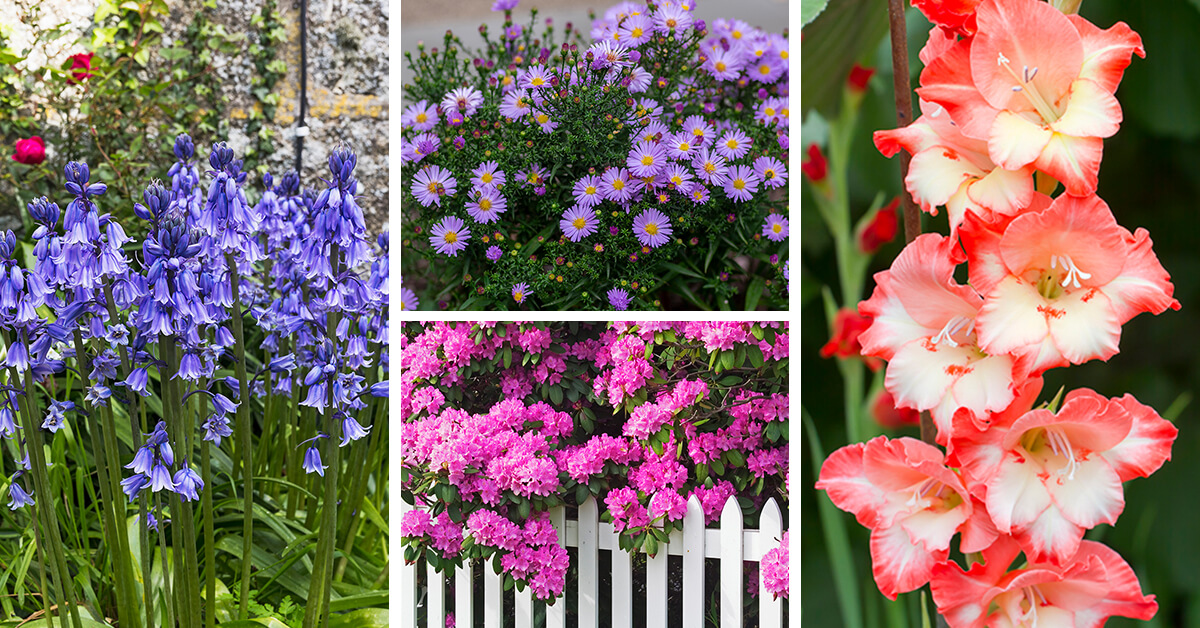There’s no denying the fact that everyone loves pretty flowers, whether you are planning to dip your toes into gardening as the seasons change, or you are looking at inspiration for what to add next, you will surely be able to find a flower that suits your needs.
The 20 Best Flowers and Their Meanings to Create Personalized Bouquets With
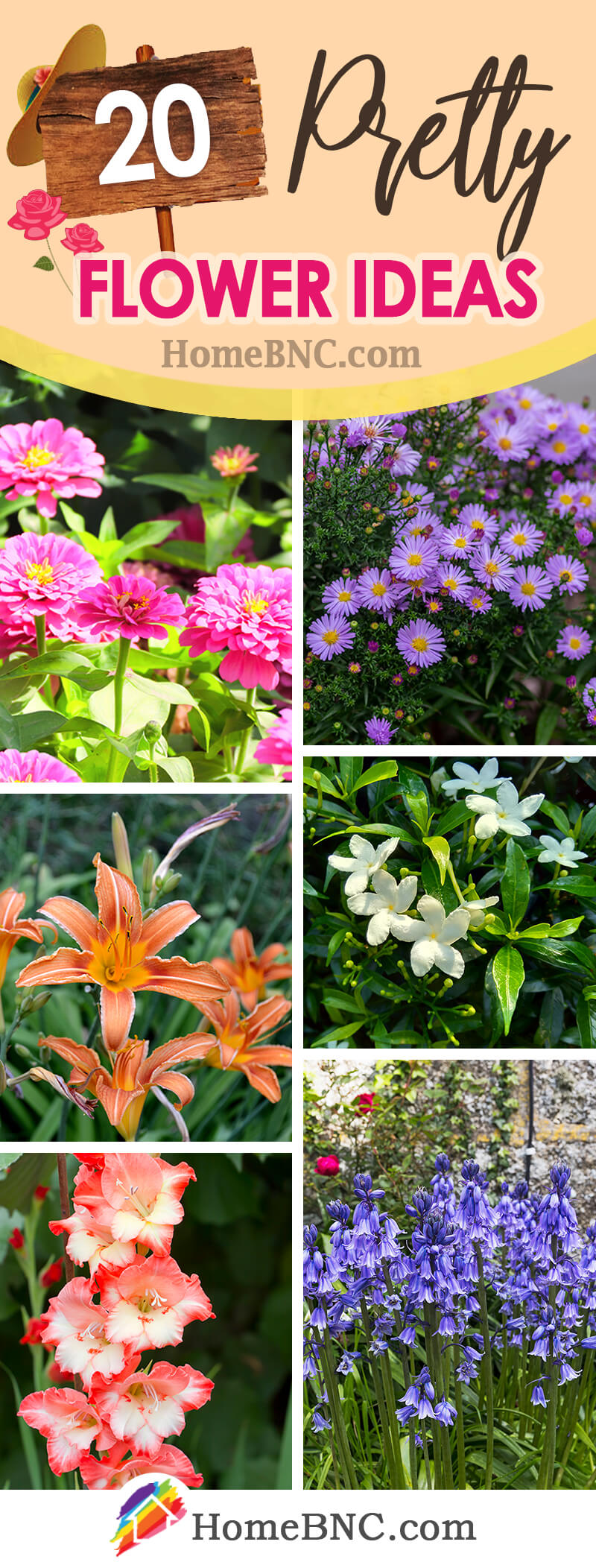
Throughout history, and particularly in the Victorian Era, flowers have had more meanings than transcend language, conveying messages and emotions without words.
1. Amaryllis (Hippeastrum)
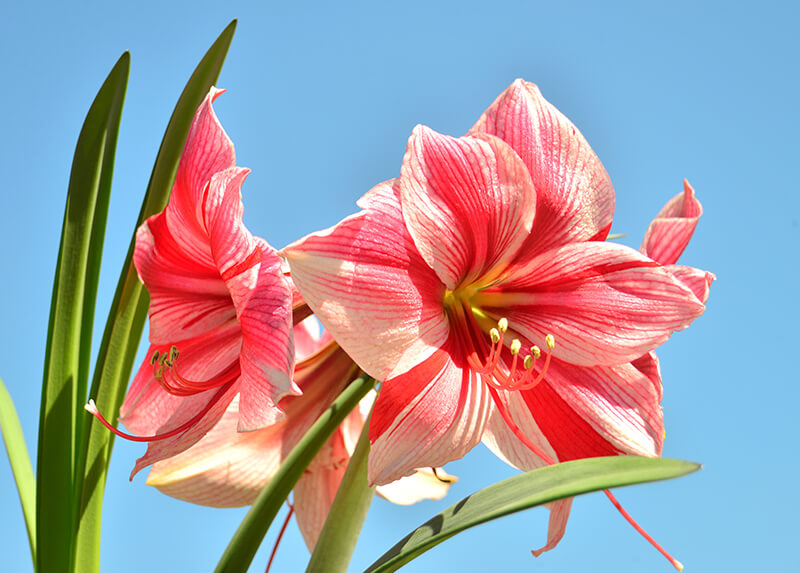
- 🔮 Symbolism: Being prideful, strong, and determined
- 💧 Water needs: Minimal, water sparingly
- 🪴 Soil needs: Well-drained potting soil
- 🌍 Growing zones: 9 to 10
- ☀️ Light needs: Partial sunlight
- 🌱 Blooming season: December through May
A six-petaled flower with red tips that gradually fade to cream color with red streaks where the leaf’s veins are stands in a garden. There is still pollen on the stamen of the amaryllis. The contrast of the red with the cream center of the petals is a great way to add spice to a bouquet or a garden. The amaryllis is a plant that has been around for quite a while, and along with that, comes a strong foundation for what it symbolizes. Its strong stem and bold colors go hand-in-hand with its meaning.
2. Aster (Symphyotrichum)
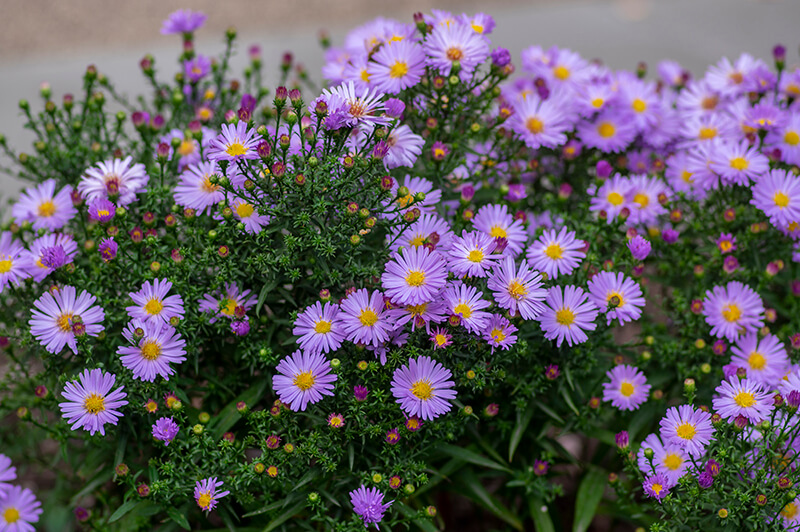
- 🔮 Symbolism: The sign of having wisdom, faith, and valor
- 💧 Water needs: Weekly, if there has been under one inch of rainfall
- 🪴 Soil needs: Well-drained, loamy, and preferably with compost
- 🌍 Growing zones: 3 to 9
- ☀️ Light needs: Partial to full sunlight
- 🌱 Blooming season: June to October
These types of pretty flowers carry an air of dainty beauty to them with their small blooms and pastel colors. Historically, the aster flower has been a sign of having wisdom, faith, and valor, coming from its connections to the stars. After all, it was named after the Greek word for “star” because of its shape. A bouquet of small light purple flowers is bundled tightly together. The center of the flowers is a pale yellow, contrasting the dark green stems. While small, these unique flowers can add to a garden by complementing the colors of other flowers, as the purple is pale enough not to detract from the larger flowers in the garden.
3. Dianthus (Dianthus)
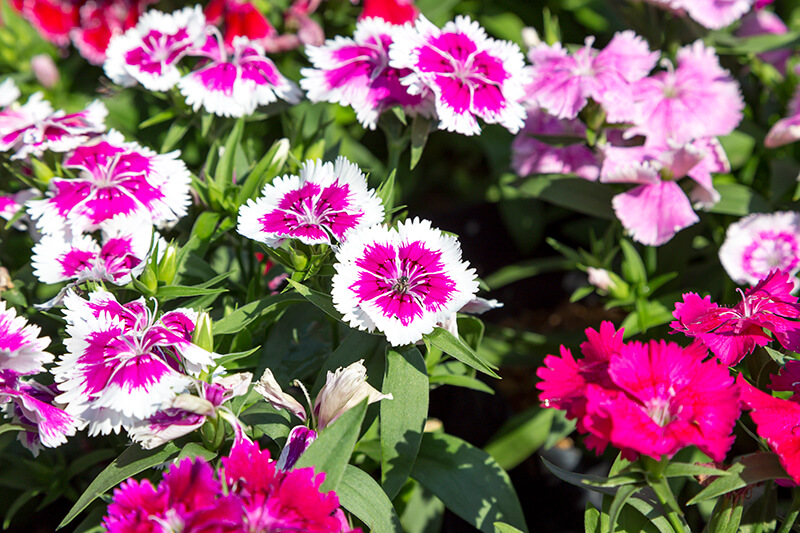
- 🔮 Symbolism: Love and affection
- 💧 Water needs: Minimal, only when the soil is dry
- 🪴 Soil needs: Well-drained with good circulation
- 🌍 Growing zones: 4 to 9
- ☀️ Light needs: Full sunlight
- 🌱 Blooming season: March to August
Sometimes known simply as “Pinks”, the Dianthus has long since been regarded as a flower that symbolizes love and affection. Even when there is no romance, this flower has been used as a sign of gratitude and admiration for the person being gifted this flower, which has also been called the flower of the Gods. With a vibrant fuchsia color and a white border around each petal, these types of pretty flowers are a great way to make a statement in your garden. Small enough not to detract from other, more magnificent plants, but bright enough to add a splash of color in the early months of spring, the Dianthus is a short, yet beloved flower.
4. Daylily (Hemerocallis)
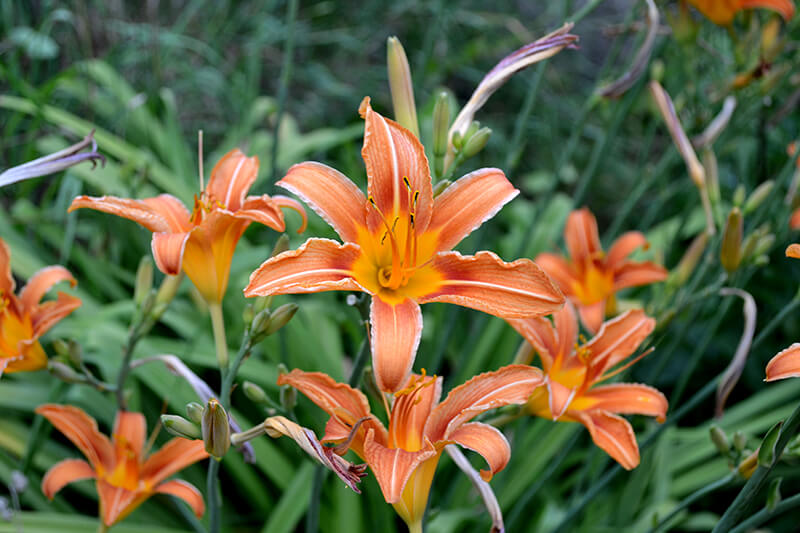
- 🔮 Symbolism: Sacrifices, devotion, and love that mothers have for their children
- 💧 Water needs: Weekly, if there has been under one inch of rainfall
- 🪴 Soil needs: Tolerant of poor soil, prefers well-drained and fertile soil with compost
- 🌍 Growing zones: 4 to 9
- ☀️ Light needs: Full sun
- 🌱 Blooming season: March to October
This flower has historically been used to represent the sacrifices, devotion, and love that mothers have for their children, making it a flower to remember if you want to create a meaningful bouquet for your mother. With a light orange body and a streak of even lighter orange running through the center of each petal, the burnt umber markings in the center of the flower are a sight to behold in person.
5. Forget-Me-Nots (Myosotis Scorpioides)
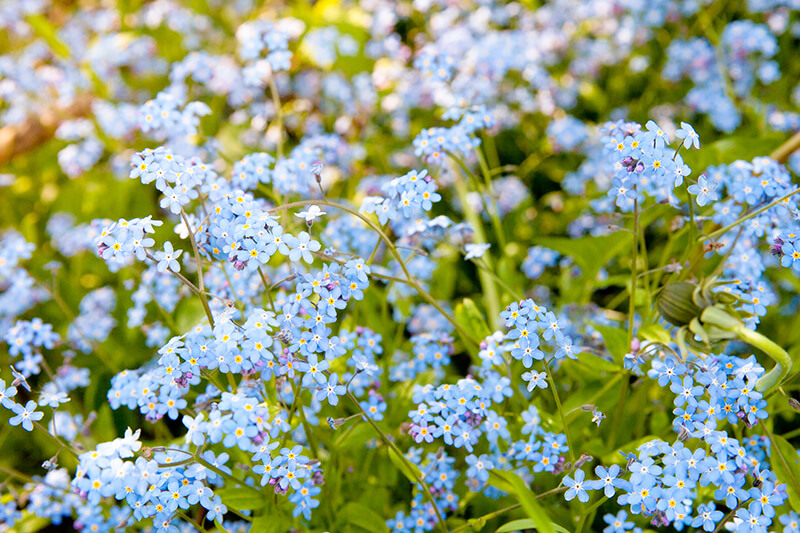
- 🔮 Symbolism: Remembrance, love, and “true love memories”
- 💧 Water needs: Regularly
- 🪴 Soil needs: Tolerates all soil conditions, does best with a neutral soil pH
- 🌍 Growing zones: 5 to 10
- ☀️ Light needs: Partial sunlight
- 🌱 Blooming season: March to August
By the name alone, it can be easy to imagine what this flower’s meaning has been throughout the ages. Often given as a parting gift or seen at funeral services, the forget-me-not is a flower that symbolizes remembrance, love, and “true love memories”. This small, baby-blue pretty flower plant has five circular petals that surround a soft, yellow center, accented by white markings. Standing out against the green backdrop of a garden, these short flowers can ease the dullness of your garden’s earthen tones while also complementing the other flowers that you have in your garden.
6. Gladiolus (Gladiolus)
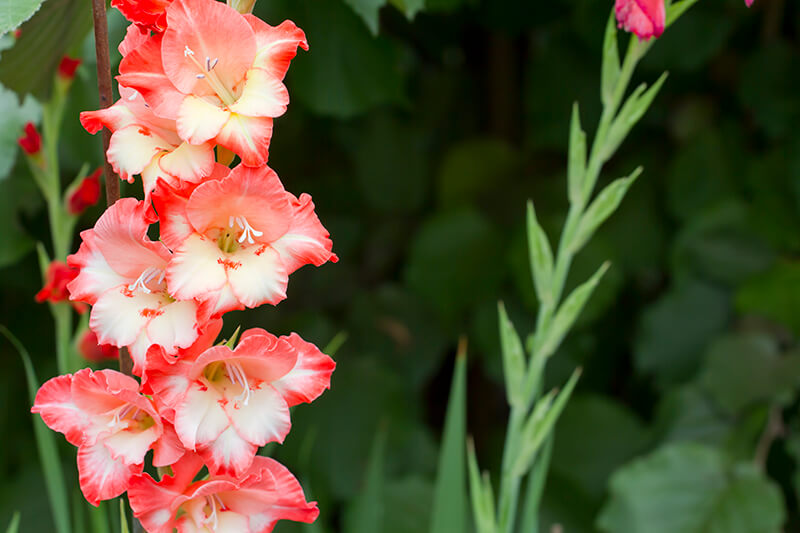
- 🔮 Symbolism: Strength, willpower, and the determination
- 💧 Water needs: Weekly, if there has been under one inch of rainfall
- 🪴 Soil needs: Well-drained, moderately fertile soil that has been loosened and tilled
- 🌍 Growing zones: 8 to 11
- ☀️ Light needs: Full sunlight
- 🌱 Blooming season: June to August
As seen in some of the images of pretty flowers, there are some that have a small and dainty appearance, but the Gladiolus is unlike those. Instead, this strong and durable flower is known to symbolize strength, willpower, and the determination that would befit a flower named after the Latin word for sword. This unique flower grows tall with numerous flowers growing from the slender green stem. These powerful flowers come in a variety of striking colors but are most commonly red. Some forms of this flower will have the most vibrant coloration toward the edge of the petals, slowly fading into white toward the center of the flower, adding an eye-catching piece to your garden.
7. Hibiscus (Hibiscus Syriacus)
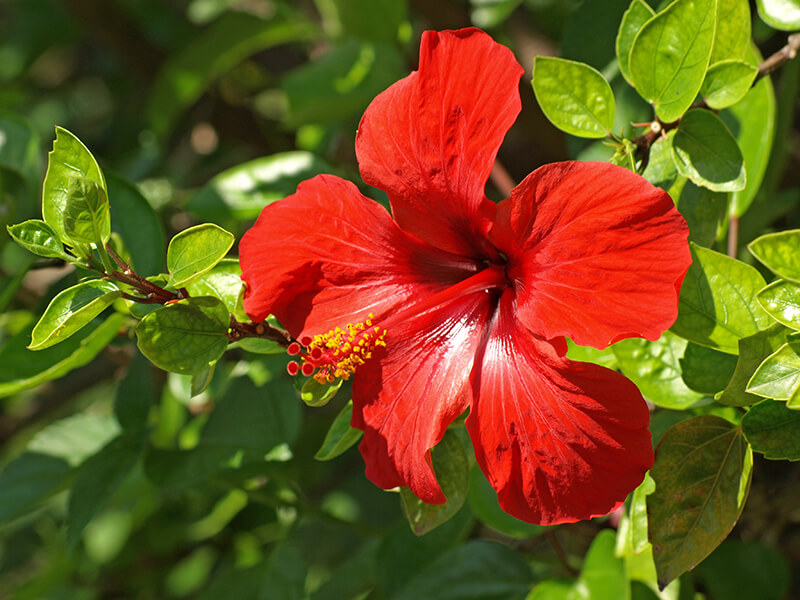
- 🔮 Symbolism: Fragility, delicate beauty
- 💧 Water needs: Thoroughly
- 🪴 Soil needs: Well-draining soil
- 🌍 Growing zones: 5 to 9
- ☀️ Light needs: Partial to full sunlight
- 🌱 Blooming season: June to October
This flower is perfect for when you need a bright patch of color in your garden. With five petals, a long stamen that is equally as vibrant in color, and a tall, leafy tree, the hibiscus is the best way to make a statement in any garden. While this hibiscus flower is bright red, flowers can range from orange flowers, to yellow, to pink, to a gradient of these colors on their ruffled petals.
8. Hydrangea (Hydrangea)
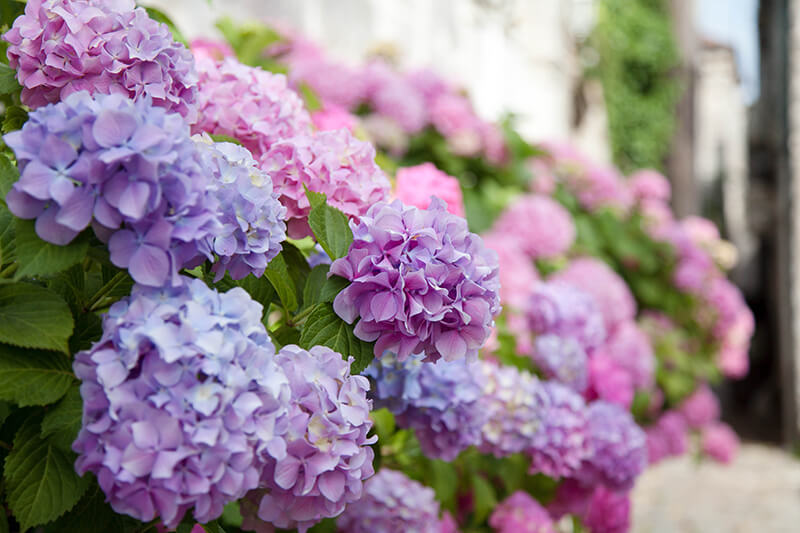
- 🔮 Symbolism: Gratitude for being understood
- 💧 Water needs: Weekly, at one inch of water per week
- 🪴 Soil needs: Tolerates all soil types
- 🌍 Growing zones: 3 to 9
- ☀️ Light needs: Shade to full sunlight
- 🌱 Blooming season: June to October
It may be surprising to see that among these pictures of pretty flowers, there are ones that come from bushes. In Victorian times, when the language of flowers was more commonplace, the flowers would be cut from the hydrangea and added to bouquets to show gratitude for being understood. Or, more passive-aggressively, signaling heartlessness.
This large hydrangea bush has the cool feature of having several different colors coming from the same plant. Because the color of the flower depends on the pH of the soil, you can have hydrangea bushes that have light pink bundles of flowers, soft blue flowers, and even a melding of the two to create a pastel purple.
9. Delphinium (Delphinium)
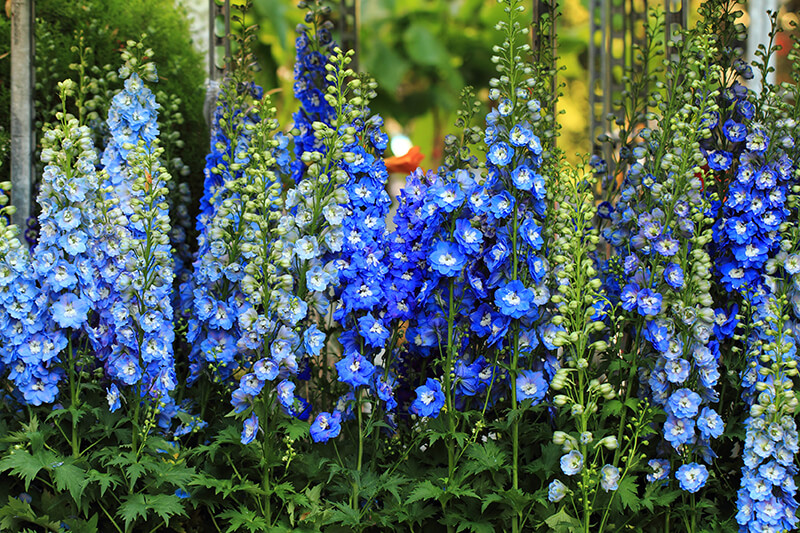
- 🔮 Symbolism: Goodwill, protection, encouragement
- 💧 Water needs: Weekly, if there has been under one inch of rainfall
- 🪴 Soil needs: Well-drained soil with compost added in, does best with alkaline soil pH
- 🌍 Growing zones: 3 to 7
- ☀️ Light needs: Partial to full sunlight
- 🌱 Blooming season: June to August
These pointed flowers that come in vibrant colors, standing out against the rest of the garden, tend to be difficult to grow. This makes it all the more impactful when one would grow these flowers in order to symbolize goodwill, protection, encouragement and remembering someone who has passed away. These types of pretty flowers are known to grow tall, with rows upon rows of beautiful blue flowers blossoming from each plant. Some flowers have a deep, rich blue hue to them, while others end up on the lighter side, adding a range of color to your garden and drawing the eyes away from the ground.
10. Lily of the Valley (Convallaria Majalis)
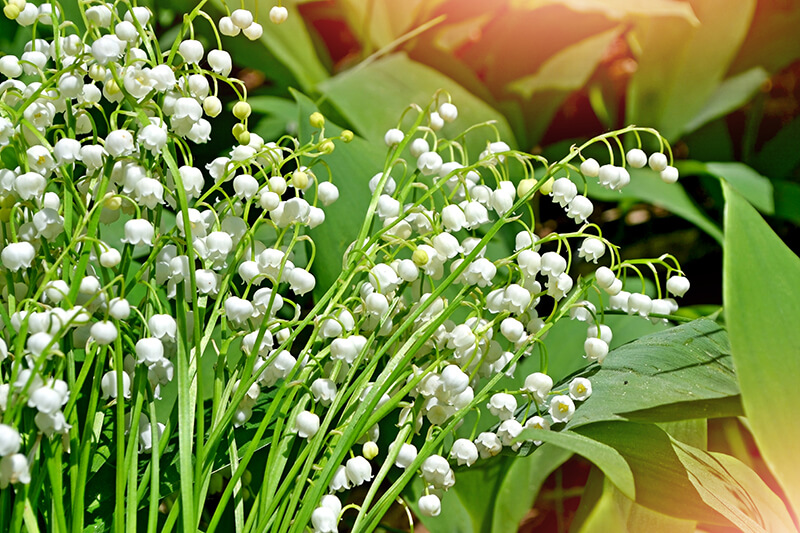
- 🔮 Symbolism: Happiness, innocence, purity
- 💧 Water needs: Thoroughly
- 🪴 Soil needs: Well-drained soil with added compost
- 🌍 Growing zones: 3 to 7
- ☀️ Light needs: Shade to partial sunlight
- 🌱 Blooming season: March to August
These small, delicate flowers are incredibly powerful in their meaning, being one of the best ways to convey happiness, innocence, purity, and in some cases, even protection from evil spirits. Interestingly enough, despite being named a lily, it is part of the asparagus family. These unique flowers come in a downward bell shape, with numerous flowers coming from each plant. With their pale-white petals and light-green stems, these flowers are a great way to balance out a garden of darker colors and add patches of soft, bright to a flourishing garden.
11. Peony (Paeonia)
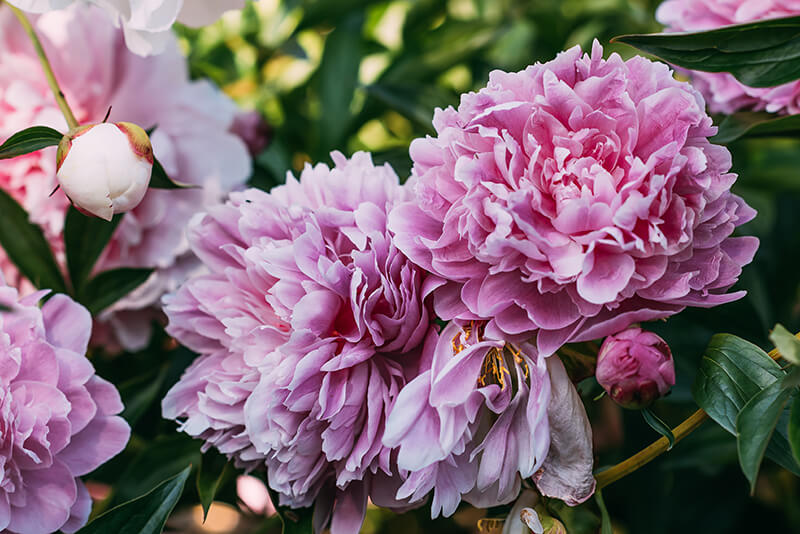
- 🔮 Symbolism: Happiness and joy
- 💧 Water needs: Thoroughly
- 🪴 Soil needs: Deep-seated, fertile, humus-rich, and well-draining soil
- 🌍 Growing zones: 3 to 8
- ☀️ Light needs: Full sun
- 🌱 Blooming season: March to August
These flowers have been long since used to symbolize happiness and joy, even dating back to the legends of Marco Polo, who would describe the blossoms as being “roses as big as cabbages”. Upon receiving these flowers as a gift, some people would add them to a salad, as all parts of the flower are edible. With dozens and dozens of thin, tiny petals layering on top of each other, these flowers are a cool way to make an impact on a garden. The flowers depicted here are a light pastel pink against their dark green leaves and stems, but peonies are known for coming in a wide variety of colors.
12. African Violet (Streoptocarpus sect. Saintpaulia)
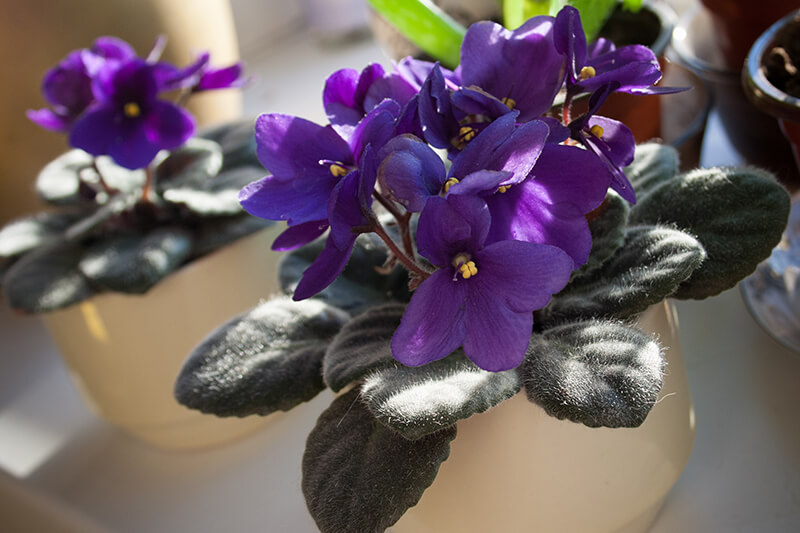
- 🔮 Symbolism: Loyalty, devotion, and faithfulness
- 💧 Water needs: Regular, keep the soil lightly moist with room-temperature water
- 🪴 Soil needs: Loose, well-drained potting soil with high organic matter
- 🌍 Growing zones: 11 to 12
- ☀️ Light needs: Partial sunlight
- 🌱 Blooming season: Year-round
Being slightly different than the widespread violets found at the start of spring, these houseplants are a great way to show loyalty, devotion, and faithfulness to someone that you love. What makes this even better is that violets of the Viola origin, while unrelated to African violets, is the birth flower of February, creating the perfect opportunity for a timely gift. These flowers are the perfect way to bring some of the garden inside your house with their deep purple petals, tiny yellow stamens, and velveteen leaves. Each plant can have several flowers blooming at once, giving you a wonderful kitchen centerpiece straight from the garden.
13. Zinnia (Zinnia Elegans)
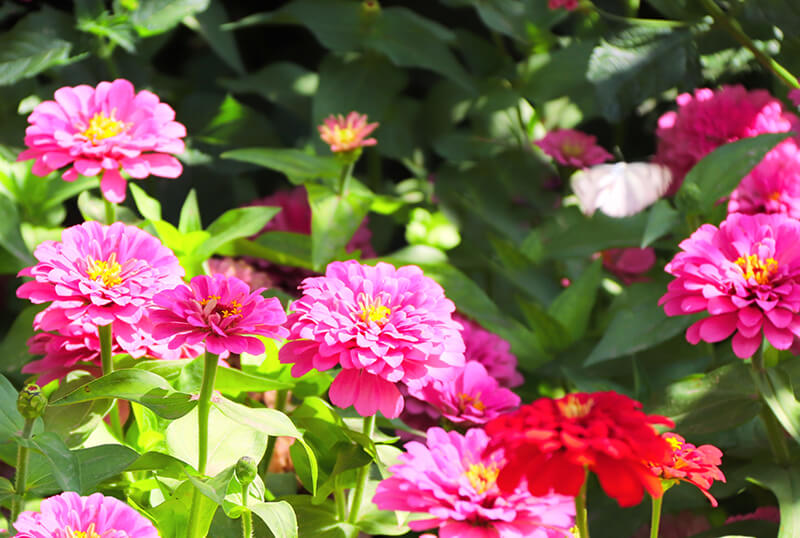
- 🔮 Symbolism: Remembrance and thoughts of friends who are absent
- 💧 Water needs: Regular, keep the soil moderately moist
- 🪴 Soil needs: Tolerant of all soils, but prefers organic matter-rich soil that drains well
- 🌍 Growing zones: 8 to 11
- ☀️ Light needs: Full sunlight
- 🌱 Blooming season: June to October
Despite their vibrant, cheerful colors, the zinnia has been known to symbolize remembrance and thoughts of friends who are absent. Perhaps it is because of their joyful, bright colors that they take on this meaning so that the absent friends can be thought of fondly. Coming in colors that range from stark whites to deep crimson, the zinnia is a flower that adds a tropical flourish to any garden. They have layers of thin, long petals that stem from the center and stack on top of each other, making them appear thick and sturdy compared to their thin, short stems.
14. Begonia (Begonia)
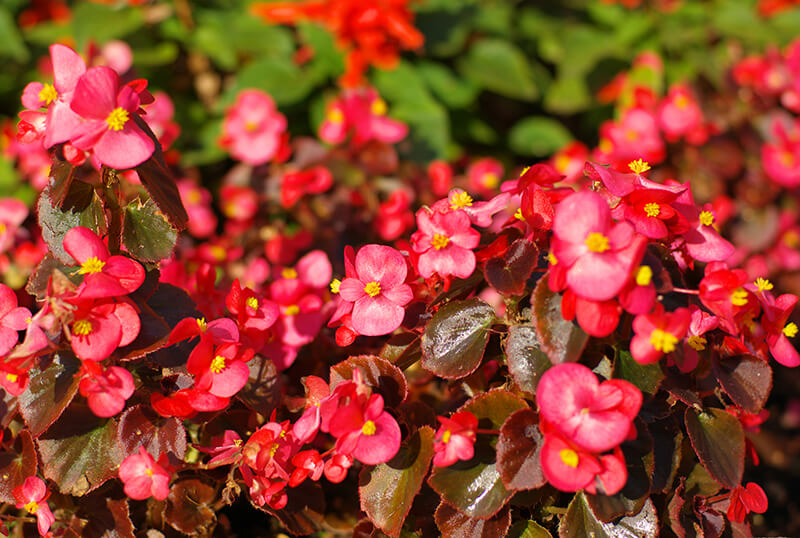
- 🔮 Symbolism: These flowers would convey messages of caution
- 💧 Water needs: Regular, keep the soil moist
- 🪴 Soil needs: Moist, well-draining soil with a high organic matter content is best for these plants
- 🌍 Growing zones: 9 to 10
- ☀️ Light needs: Partial sunlight to full sunlight
- 🌱 Blooming season: June through August
Ever since the times of the Victorian flower language, the begonia has been a dual-sided flower. Their white or red petals may seem enticing at first glance, but these flowers would convey messages of caution or that bad luck was on the horizon when they were not being used to express gratitude. With two types of begonias pictured here, only a small glimpse of the range of colors this flower comes in can be understood. With a vibrant red or a contrasting white, this four-petaled flower grows in a bush-like manner, adding the perfect accents to any garden. The leaves can also range from a ruddy brown to a dark green, further adding to the juxtaposition of this flower’s colors.
15. English Bluebell (Hyacinthoides Non-scritpa)
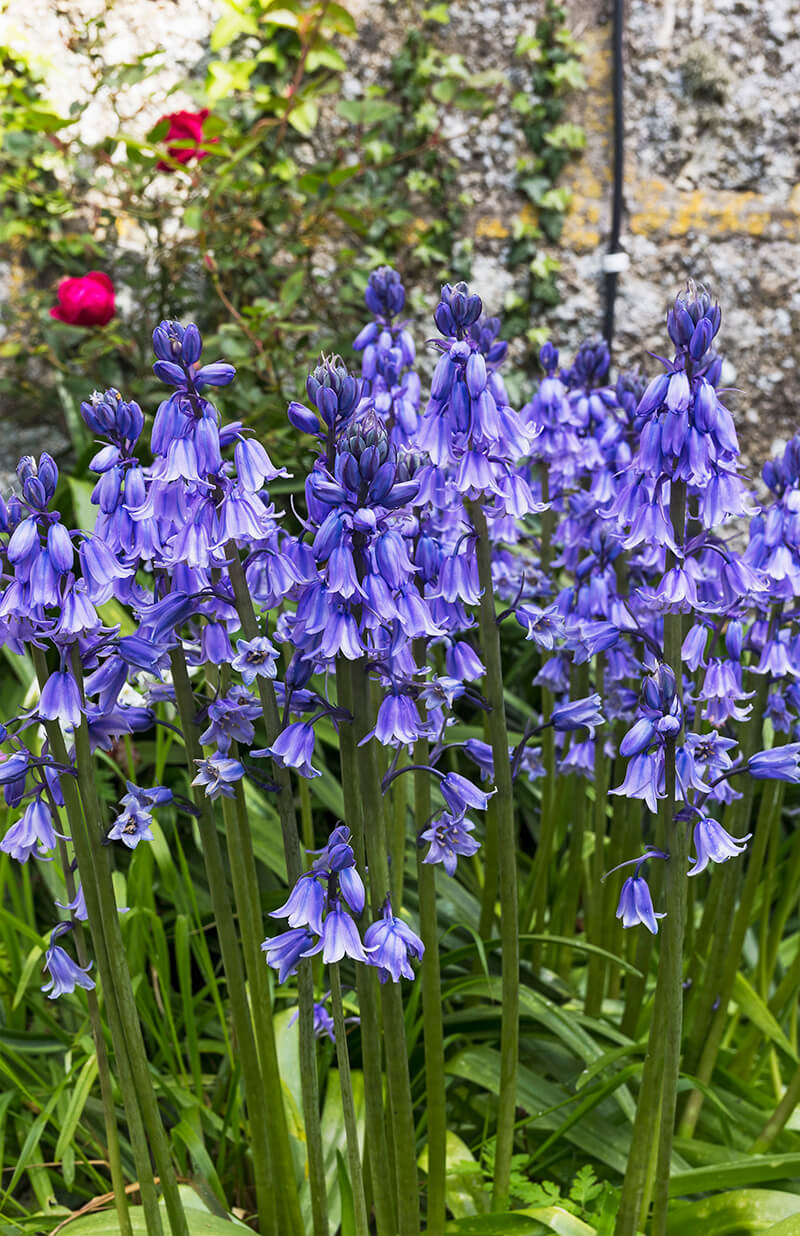
- 🔮 Symbolism: Humility, gratitude, and everlasting love
- 💧 Water needs: Regular, keep the soil slightly moist
- 🪴 Soil needs: Moist, well-draining soil that is moderately fertile
- 🌍 Growing zones: 4 to 79
- ☀️ Light needs: Partial sunlight
- 🌱 Blooming season: March to May
These flowers, appearing almost out of a fairy-filled forest, carry an equally wistful and longing feeling when given as a gift. Typically, these flowers are known to symbolize humility, gratitude, and everlasting love. This unique flower is known for its iconic bell-shaped flowers. The long petals are angled downwards, splaying out at the ends, giving the flower the shape it is best known for. Toward the top of the flower, the blue hue deepens, adding a layer of depth to its beauty.
16. German Chamomile (Matricaria Chamomilla)
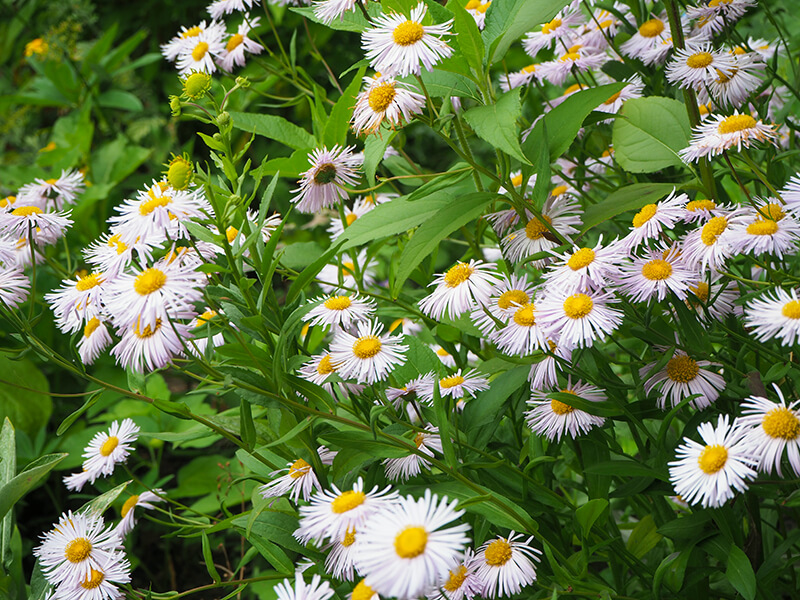
- 🔮 Symbolism: Restfulness, peace, and tranquility
- 💧 Water needs: Minimal
- 🪴 Soil needs: Light, sandy soil that has good drainage is best for this plant
- 🌍 Growing zones: 5 to 8
- ☀️ Light needs: Partial sunlight to full sunlight
- 🌱 Blooming season: June to July
When not being used to brew the medicinal chamomile tea, the meaning that this flower carries is much the same as the effects it can have on the human body. This flower is known for bringing a message of restfulness, peace, and tranquility. With long, thin stems, these beautiful white flowers can make an impact on any garden. Featuring elongated petals that are angled ever-so-slightly downward, the bulging yellow flower center stands above the rest of the flower, adding a unique addition to any garden.
17. Dahlia (Dahlia)
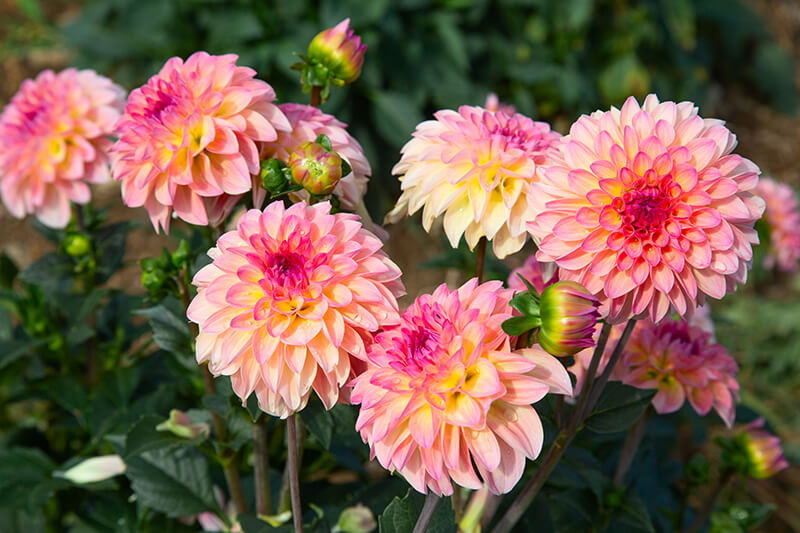
- 🔮 Symbolism: Elegance, creativity, dignity, and poise
- 💧 Water needs: Regular, two to three times per week for half an hour with a sprinkler once established
- 🪴 Soil needs: Rich, well-drained soil. Soil pH should range between 6.5 and 7.0
- 🌍 Growing zones: 6 to 11
- ☀️ Light needs: Full sun
- 🌱 Blooming season: June to October
Any flower with as rich and plentiful petals and colors as the dahlia would carry just as important of a meaning. Generally speaking, dahlia flowers are used to portray elegance, creativity, dignity, and poise. Some color-specific meanings exist, with white flowers leaning more toward purity and red flowers leaning more toward romanticism. Several different dahlia flowers can be seen, each one a more vibrant color than the other. The petals are curved in a way that almost makes the flower look like a hive. Each flower comes in its own bright color, whether that is purple, rose-red, a gradient of yellow to pink or a bright Easter yellow with flecks of red spattered across the petals.
18. Gardenia (Gardenia Jasminoides)
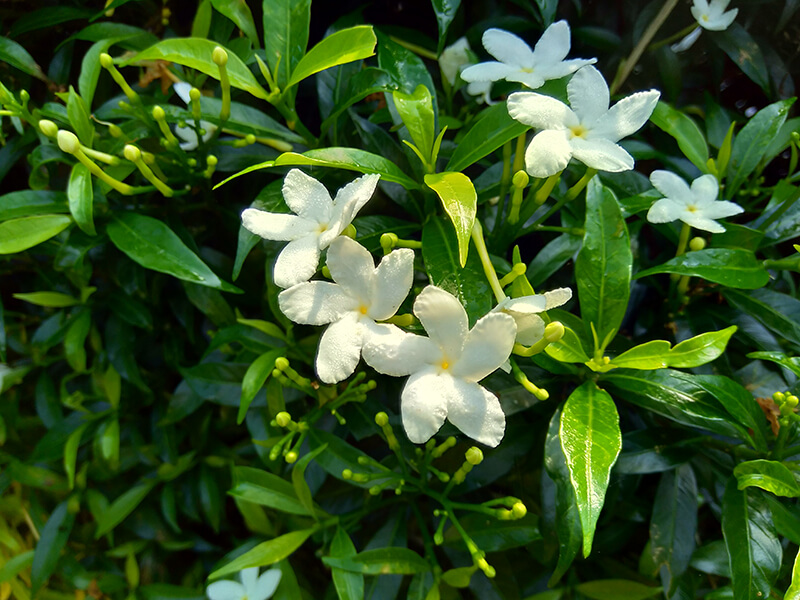
- 🔮 Symbolism: Secret love
- 💧 Water needs: Regular, alongside misting during dry spells
- 🪴 Soil needs: Rich, moist soil that is capable of draining well
- 🌍 Growing zones: 7 to 11
- ☀️ Light needs: Partial sunlight to full sunlight
- 🌱 Blooming season: March to August
It would make sense that a flower that looks as similar to a rose as the gardenia does would also have a meaning relating to love and romance, just as roses do. When used in the language of flowers, gardenias carry the meaning of secret love. With canvas-white petals spiraling outward from the center, it’s easy to mistake the white Gardenia for a white rose. However, the wider display of petals, the distinct lack of thorns, and the bush that the Gardenia grows on, give it a distinct appearance.
19. Saucer Magnolia (Magnolia x Soulangeana)
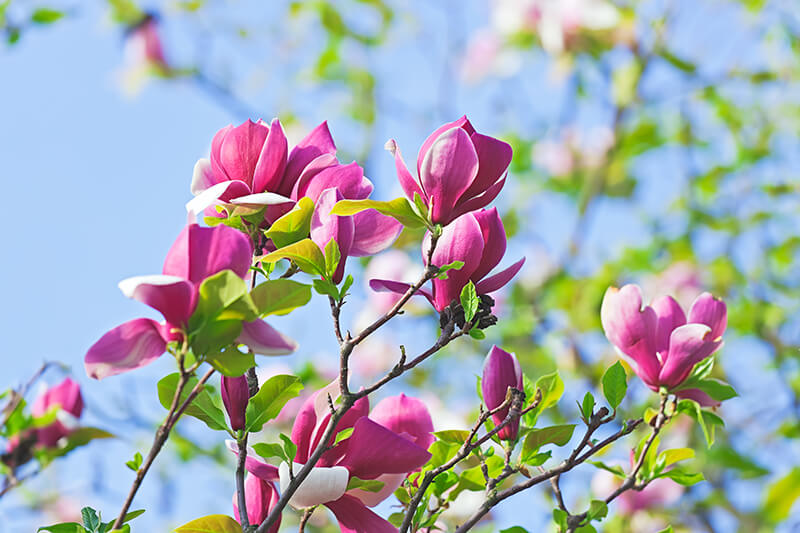
- 🔮 Symbolism: Perseverance, a connection to nature, femininity, and a degree of innocence and youth
- 💧 Water needs: Frequently during the first year of planting, switching to only watering during dry spells
- 🪴 Soil needs: Moist, rich soil that is well-drained and loamy is optimal, although clay soils are tolerated
- 🌍 Growing zones: 4 to 9
- ☀️ Light needs: Partial sunlight to full sunlight
- 🌱 Blooming season: March to May
While the specific meaning of the Magnolia flower can depend on the color of its petals, the gentle pink petals of the Saucer Magnolia help it stand out from the rest. It symbolizes perseverance, a connection to nature, femininity, and a degree of innocence and youth. Out of all the pictures of pretty flowers, there is one thing that stands out about the Saucer Magnolia, and that is its gorgeous pastel-pink petals. With petals reaching toward the sky, marked with a dark pink streak running by the edges, the Magnolia tree is the perfect addition to make to any garden.
20. Rhododendron (Rhododendron)
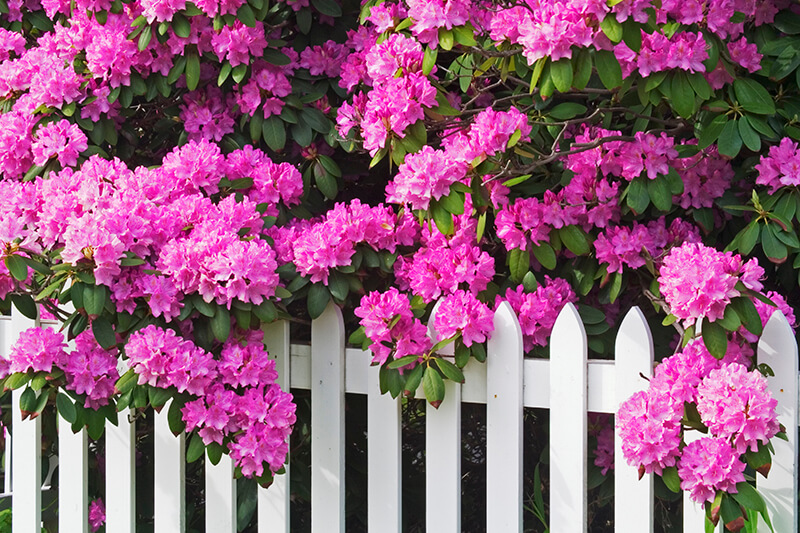
- 🔮 Symbolism: Energy, optimism, cheerfulness, and warmth
- 💧 Water needs: Weekly, if there has been under one inch of rainfall
- 🪴 Soil needs: Well-draining, humus-rich, moist soil is optimal
- 🌍 Growing zones: 3 to 9
- ☀️ Light needs: Shade to partial sunlight
- 🌱 Blooming season: March to October
These strong and showy flowers have long since been used to display energy, optimism, cheerfulness, and warmth. Depending on the color of the Rhododendron, it can also carry meanings of love, affection, and passion. The Rhododendron is one of the most well-known pretty flower plants out there, with its bunches of purple-pink five-petaled flowers branching out of its bush-like form. Each branch of the bush contains tens of flowers, and each one with just as much color as the last, the Rhododendron is a great way to add low-lying color to a garden.
20 of the Most Meaningful Flowers to Make Your Garden Stand Out
By understanding some of these meanings, you can build a garden that truly has a unique message, and with those flowers, you can convey the feelings you may have to friends, lovers, and acquaintances alike. And, beyond the meanings of the flowers, they can make your garden a sight to behold every morning with their distinct appearances.

